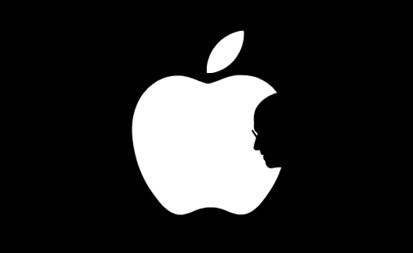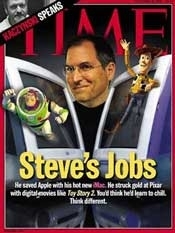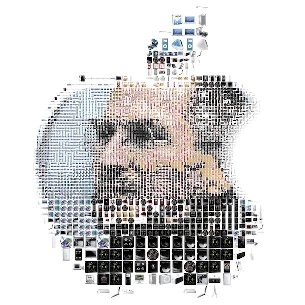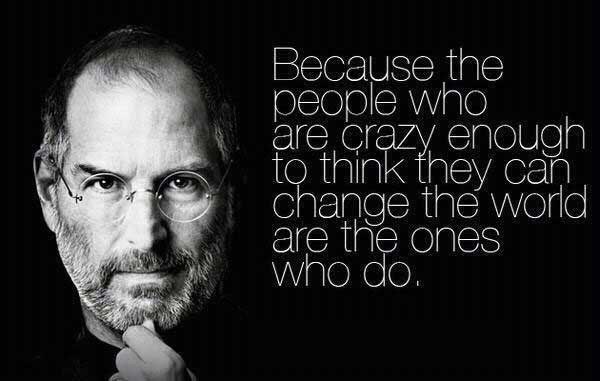 |
| (http://www.youthedesigner.com/wp-content/uploads/2011/10/steve-jobs-apple-logo.png) |
At
the age of twelve, a young boy named Steve Jobs joined a Hewlett-Packard
computer/software club and immediately knew he wanted a profession in computers.
That young boy grew up to become the founder of Apple Computer, which now
stands as the most valuable company in the world with a market capitalization
of over 346 billion dollars. Born in 1955, it was a lucky coincidence for Steve
that his adoptive parents, Paul and Clara, moved the family from
 |
| The Rise of Apple (http://finance.yahoo.com/echarts?s=AAPL+Interactive#symbol=AAPL;range=my ()) |
Steve Jobs was
passionate about computers from an early age, but this was only one of his
passions. He strived to infuse all his
passions into his life's work, to become a true pioneer of the personal
computer era. Jobs' passions included
the aesthetic, which he learned from a college course in calligraphy, and the esoteric,
which he pursued in a spiritual quest in India. After returning from India, Jobs was driven
back to his first passion:
In Silicon Valley in the autumn of 1974, Jobs reconnected with Stephen Wozniak, a former high school friend who was working for the Hewlett-Packard Company. When Wozniak told Jobs of his progress in designing his own computer logic board, Jobs suggested that they go into business together, which they did after Hewlett-Packard formally turned down Wozniak's design in 1976. The Apple I, as they called the logic board, was built in the Jobs' family garage with money they obtained by selling Jobs' Volkswagen minibus and Wozniak's programmable calculator. (Jobs, Steve. Britannica Biographies)
With almost no money, no car, and little privacy Steve Jobs
had a rough draft of his life's work, at least his life's work with
computers. Jobs devotion to his product
and insistence that it be simple yet elegant shows the drive he had to create
something of real value. Several times
Jobs faced disappointment, including being fired from Apple, but Jobs passion
for technology kept him in the game. With Apple on the brink of bankruptcy due
to his absence, Jobs returned to the company and his passion for products
enabled him to innovate with yet another marvelous product, the iMac. His continued
passion propelled him to make some of the most remarkable advances of his
career when most men would have quietly retired. Not even cancer could stop him from
fulfilling his dreams.
In June 2009 the Wall Street Journal reported that Jobs had received a liver transplant the previous April. Not disclosed was whether the pancreatic cancer he had been treated for previously had spread to his liver. The operation was performed in Tennessee, where the average waiting period for a liver transplant was 48 days, as opposed to the national average of 306 days. Jobs came back to work on June 29, 2009, fulfilling his pledge to return before the end of June. (De Anza College)
Jobs' body of work in the computer
industry was already remarkable yet he did not leave the business simply
because of health issues. He still had
work to do and his passion led to the culmination of his career: the iPad.
During times of difficulty and times of luxury Jobs came into "work"
with an open mind and passion for technology, which led him to his
success.
 |
| Jobs on Time Magazine (http://www.whosdatedwho.com/tpx_2780671/time-magazine-united-states-18-october-1999/ ()) |
Steve
Jobs' vision came when the average person didn't even realize he wanted a
computer, much less have any idea that he could own one.
Jobs had realized there was a huge gap in the computer market. At that time almost all computers were mainframes. They were so large that one could fill a room, and so costly that individuals could not afford to buy them. Advances in electronics, however, meant that computer components were getting smaller and the power of the computer was increasing. Jobs and Wozniak redesigned their computer, with the idea of selling it to individual users. Because jobs was able to be a step ahead of his opponent, Jobs was able sell it to individual users and it went on to make over 200 million dollars over the next 3 years. (Jobs, Steve.UXL)
Jobs transformed
the computer industry into something it had never been before. personal. The realization of
Jobs' vision was to become the most valuable company in the world: Apple
Inc. Jobs' bold ideas led to the
creation of many advances in technology such as the graphic user interface or
"GUI", the laptop, the mouse, touch screens, iPod, iPhone, and iPad, which have
forever given a new meaning to the personal computer. However, Jobs' vision was not limited to
personal computer products. He took a risk on a struggling animation company,
which turned out to be another one for the record books, when he bought Pixar
and turned it into a movie making success story.
In 1986 Jobs purchased a small company called Pixar from filmmaker George Lucas (1944-). Pixar specialized in computer animation. Nine years later Pixar released Toy Story, a huge box office hit. Pixar later went on to make Toy Story 2 and A Bug's Life, which Disney distributed, and Monsters, Inc. All these films have been extremely successful. Monsters, Inc. had the largest opening weekend ticket sales of any animated film in history. (Encyclopedia of World Biography)
 |
| The Face of Apple (http://themancavedaily.com/wp-content/uploads/2011/10/Steve-Jobs.jpg) |
Steve Jobs was a
clever and ingenious man who never hungered for fame and fortune; instead he
thrived on innovation. In 1984, Jobs had already tasted success with the first
Apple computers, but he knew that something was missing from the computer.
In 1984 Apple introduced a revolutionary new model, the Macintosh. The on-screen display had small pictures called icons. To use the computer, the user pointed at an icon and clicked a button using a new device called a mouse. This process made the Macintosh very easy to use. (Encyclopedia of World Biography)
 |
| http://blog.mason23.com/bid/119211/Leadership-and-Brands-What-made-Steve-Jobs-a-great-leader () |
We will never know
what more Steve Jobs could have envisioned, would have been passionate about,
or what genus he could have devised had he lived another 20 or 30 years. We
were robbed of Steve's gifts all too soon when he died at the age of 56. But I can
imagine that he's shaking things up on the other side. As he was leaving this
world on October 5, 2011, his last words were "oh wow, oh wow, oh wow" (Isaacson).
Was that a realization of the immense contribution that he made to this world?
Or was it a passionate reinvigoration of vision when presented amazing new opportunities
to continue innovating on the other side? Steve once said "The people who are
crazy enough to think they can change the world are the ones who do." (Isaacson).
Steve Jobs was not a great
philanthropist or salesman military leader, but he changed the world, and for
that, he is a hero.
Works Cited
De Anza College.
"California Community Colleges Chancellor's Office Newsroom Notable Alumni
Steve Jobs." California
Community Colleges Chancellor's Office Newsroom Notable Alumni Steve Jobs.
California Community Colleges Chancellor's Office, 2011. Web. 22 May 2012
Encyclopedia of
World Biography. "World Biography." Steve
Jobs Biography. Encyclopedia of World Biography, 2012. Web. 10 May 2012.
Isaacson, Walter. Steve Jobs. New York: Simon
& Schuster, 2011. Print.
"Jobs, Steve." Britannica Biographies
(2011): 1. Biography Reference Center. Web. 8 May 2012.
Jobs, Steve ." UXL Encyclopedia of World Biography.
Ed. Laura B. Tyle. Vol. 6. Detroit: UXL, 2003. 1007-1010. Gale
Virtual Reference Library. Web. 7 May 2012.
http://californiacommunitycolleges.cccco.edu/Newsroom/NotableAlumni/SteveJobs.asp.
Page created on 5/25/2012 12:00:00 AM
Last edited 5/25/2012 12:00:00 AM
